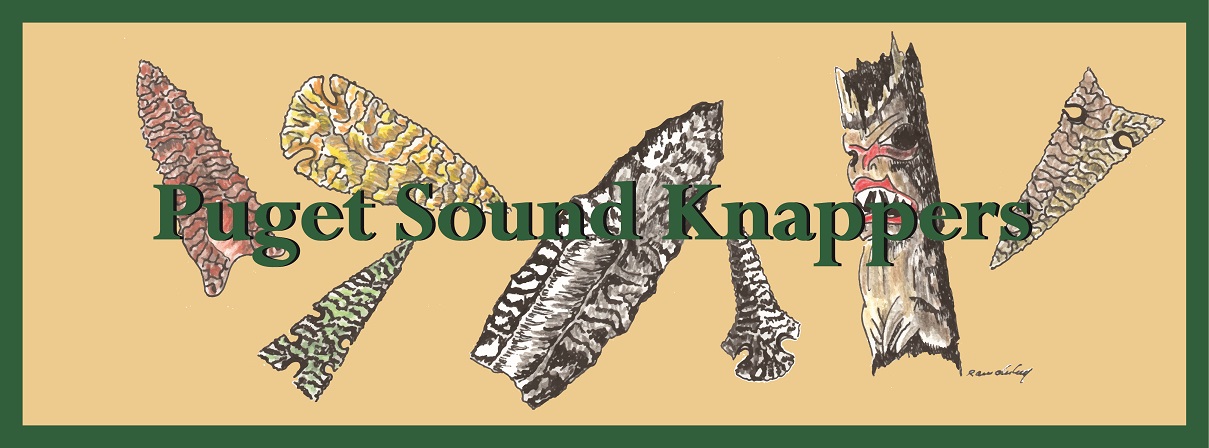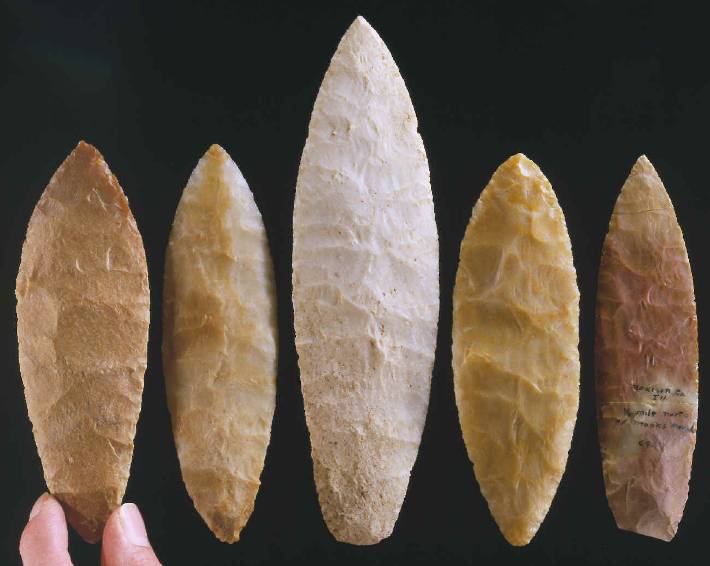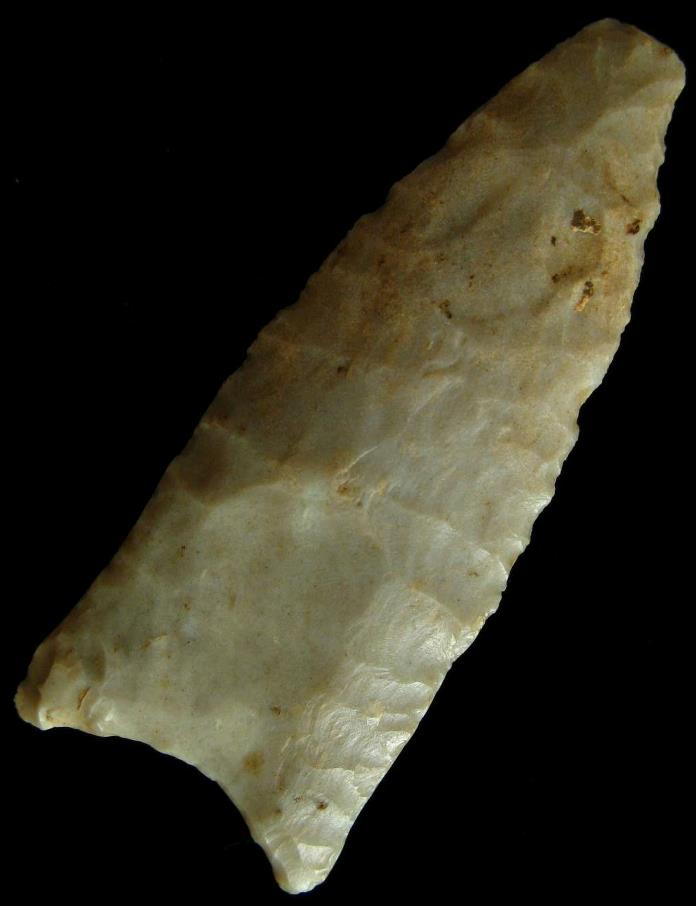 |
 |
|
Raccoon Creek Raccoon Notched (also known as “Raccoon Creek,” the two Raccoon designations are employed in the extreme northeast U.S. while in the southeast, the term “Knight Island” is used. The point form is found in this database under “Knight Island”) Raddatz Associated Dates: 5000 – 2000 BC
ABOVE: RADD01: Common Raddatz point outlines. Source: Minnesota State University at Mankato General Description: Raddatz points are named for the Raddatz Rock Shelter site, south-central Wisconsin. RADDATZ POINT THUMBNAIL GALLERY (30 images: 15 source images/15 thumbnails)
End of Raddatz Thumbnails - Complete
ABOVE: RADD02 AND RADD03: Raddatz point; Johnson Co., Missouri; 2.13 inches (54.1mm)
ABOVE: RADD04: Raddatz point; Clay Co., Arkansas; 1.88 inches (47.7mm)
ABOVE: RADD05: Raddatz point; Illinois; 1.13 inches (28.7mm)
ABOVE: RADD06 AND RADD07: Raddatz point; southern St. Louis Co., near St. Louis, Missouri; 2.5 inches (63.5mm)
ABOVE: RADD08 AND RADD09: Raddatz point; Miller Co., Missouri; 2.0 inches (50.8mm)
ABOVE: RADD10 AND RADD11: Raddatz point; Miller Co., Missouri; 2.0 inches (50.8mm)
ABOVE: RADD12: Raddatz points; Sumac Bluffs Site, Chippewa River, north of its confluence with the Pine River, Michigan; first of two views
ABOVE: RADD13: second of two views of Raddatz points described above
ABOVE: RADDATZ14 AND RADDATZ15: Raddatz point, variant (see additional note below*); Van Buren Co., Iowa; 2.43 inches (61.7mm); Burlington chert. Source: Arrowheadsplus dot com. (*according to Jonathan Floming, this point is “…an unusual variant that appears to be a blending form of the Raddatz and Mantanzas, more than likely a Helton phase artifact and probably dates the same.” End of Raddatz - Complete Radkin Ramey Knife (Note - changes were made to original document to reflect corrections in labeling) Associated Dates: 5000 – 4000 Y.B.P.
ABOVE/Center: RAMEY01: Ramey Knife; Randolph Co., Illinois; size not given General Description: A large lanceolate point that is widest near the upper one third of its length, tapering convexly to an unfinished round basal end. A frequently used specimen may have a pointed basal end. Named by Gregory Perino after the Ramey Site at Cahokia Mounds. Distribution: The center of distribution is the Cahokia site, and where all other Cahokia Sites occur, primarily in Missouri, Wisconsin and various parts of Illinois.
ABOVE: RAMEY02: Ramey Knives; the one at left, from Madison Co., Illinois, is 6.72 inches (168mm); the one at right, from the Snyder Site, Calhoun Co., Illinois is in length and the smaller is 4.88 inches (122mm); resharpening of the latter makes it look remarkably similar to a Harahey knife RAMEY KNIFE THUMBNAIL GALLERY (48 images: 24 source images/24 thumbnails)
End of Ramey Knife Thumbnails - Complete
ABOVE, LEFT: RAMEY03: Ramey Knife; Missouri; 8.75 inches (218.75mm) ABOVE, RIGHT: RAMEY04 AND RAMEY05: Ramey Knife; southern Illinois; 7.5 inches (187.5mm)
ABOVE: RAMEY06: Ramey Knife; Lloyd Site, Madison Co., Illinois; officially designated as A-41:3 and one of two Ramey Knives from the site which show traces of two pigments – hence their description as “painted” Ramey Knives (see pigment distribution in frame #06 below and enlargement of a pigment residue area in frame #09; 7.5 inches (187.5mm); Mill Creek chert. Source: Lithic Casting Lab
ABOVE, LEFT: RAMEY07: distribution of red and green pigments on Ramey Knife described above in frame #06)
ABOVE: RAMEY09: a green copper pigment spot on Ramey Knife discussed above in frame #’s 05, 06, 07. Source: Lithic Casting Lab
ABOVE: RAMEY10: a red ochre pigment spot on Ramey Knife discussed above in frame #’s 05, 06, 07 and 08. Source: Lithic Casting Lab
ABOVE, LEFT: Ramey11: second example of a painted Ramey Knife from the Lloyd Site, Madison Co., Illinois; green dots show copper pigment locations while red ones indicate red ochre areas; 7.5 inches (187.5mm); Mill Creek chert. Source: Lithic Casting Lab ABOVE, RIGHT: RAMEY12: reference image to provide context for the image in frame #11; see enlargement below in frame #13. Source: Lithic Casting Lab
ABOVE: RAMEY13: enlargement of Ramey Knife image above in frame #11. Source: Lithic Casting Lab
ABOVE: RAMEY14: Ramey Knives; all are artifacts, not modern reproductions; the white ones are Burlington chert; the tan ones are Mill Creek chert; the ones with a deep orange color are Kaolin chert (the light-sand colored one in the upper right is Mill Creek, not Kaolin). See selected enlargement below. Source: Pete Bostrom, Lithic Casting Lab
ABOVE: RAMEY15: enlarged partial view of Ramey Knife assembly described above in frame #14. Source: Pete Bostrom, Lithic Casting Lab
ABOVE: RAMEY16: Ramey Knives; Illinois sources with exception of second from right which is believed to be from Rhea Co., Tennessee; smallest point shown is 6.88 inches (172mm), largest is 9.5 inches (237.5mm). All are made from Mill Creek chert. Source: Pete Bostrom, Lithic Casting Lab
ABOVE: RAMEY17: Ramey Knife; quarter-mile north of Monks Mound, Madison Co., Illinois; 6.13 inches (153.25mm). Source: Pete Bostrom, Lithic Casting Lab 
ABOVE: RAMEY18: Ramey Knives; Illinois; Kaolin chert; smallest is 6.13 inches (153.25mm) while largest is 8.31 inches (207.75mm). Source: Pete Bostrom, Lithic Casting Lab
ABOVE: RAMEY19: Ramey Knife; Fulton Co., Illinois; 8.31 inches (207.75mm); Kaolin chert. Source: Pete Bostrom, Lithic Casting Lab
ABOVE: RAMEY20: Ramey Knife; St. Clair Co., Illinois; a fairly rare example of a Ramey Knife made from Burlington chert. Source: Pete Bostrom, Lithic Casting Lab
ABOVE: RAMEY21: Ramey Knife; Madison co., Illinois; 6.5 inches (162.5mm); example of a Ramey Knife showing use-wear; many show none and may have been ceremonial. Source: Pete Bostrom, Lithic Casting Lab
ABOVE: RAMEY22 AND RAMEY23: examples of Ramey Knife shape variations; these two have been compared to Aztec bifaces from the Central Valley of Mexico which they greatly resemble. The one on the left is from Horse Shoe Lake Island, Cahokia Mounds site, Madison Co., Illinois and is 6.5 inches (162.5mm); Mill Creek chert. The on the right is from Madison Co., Illinois, and measures 5.13 inches (128.25mm); Burlington chert. Source: Pete Bostrom, Lithic Casting Lab
ABOVE: RAMEY24: Ramey Knife; Brown Co., Illinois; 9.5 inches (237.5mm); Mill Creek chert. Source: Pete Bostrom, Lithic Casting Lab End of Ramey Knife - Complete Randolph Associated Dates: 2000 - 200 Y.B.P.- Woodland to Historic Also See: Bradley Spike, Flint River, Schild Spike, Duval, Mountain Fork, New Market Location: Far Eastern United States Morphology: Stemmed
General Description: The Randolph arrow point is a small to medium sized, narrow, thick, crudely made with poorly controlled flaking resulting in sometimes highly asymmetric outlines. Overall a spike point with tapered shoulders, a median ridge, and a medium contracting rounded short stem. The blade is thick and narrow, parallel sided to triangular in outline. The shoulders are obtuse to angular. Some examples exhibit one shoulder barb which is highly exaggerated in size when compared to the other shoulder barb. It appears that many Randolph points were fashioned from waste flakes or conserved, broken points from earlier periods. The Bradley Spike is almost identical in size and description and is probably a Tennessee derivation. Justice suggests that the Randolph is perhaps a correlate to the Ledbetter Cluster of points (Ledbetter and Pickwick types). Coe believes "The Aboriginal culture in the Piedmont area disintegrated rapidly after 1700 A.D. The Randolph was made between 1700 A.D. and 1800 A.D. by aboriginal cultures in the Piedmont area who lived in small destitute bands and who could not continually supply themselves with adequate guns and ammunition. As a result they found it necessary to return to the bow and arrow for hunting and exhibition. These groups gave birth to the point type known as the Randolph Stemmed." The Randolph is primarily found in North Carolina, and eastern Tennessee. It is found in decreasing numbers in adjoining states. The Randolph point ranges in size from 25 mm to 55 mm in length. The width across the barbed shoulders ranges from 15 mm to 25 mm. The stem length ranges in size from 9 mm to 16 mm long. The stem width ranges from 9 mm to 17 mm. The Randolph point was named by Joffre L. Coe in 1964 for examples he found in Randolph County, North Carolina. About the next Point: The point pictured here is a large sized Randolph point. This specimen is made from a dark brown and gray glossy flint. The point measures 51 mm in length, 27 mm at the widest point (across the shoulders) and is 11.5 mm thick at mid blade just above the shoulders.
ABOVE: RAND01: Randolph point; see description above The hafting area thins down to 5 mm in thickness and is 10.5 mm wide. The stem is 15 mm long. The basal edge is rounded and is not ground. The point is very crudely knapped and is wonderfully asymmetric in outline. The point is obtuse. The point shows the signs of fire pocking in the form of small circular craters which are on both sides of the specimen (see tip area and lower stem). This point was a surface find in corn fields along the James River, near the town of Hearns Crossroads, Sussex County, Delaware. (TEXT SOURCE: Art Gumbus, Lithics-Net)
ABOVE: RAND02: Randolph point; Montgomery Co., North Carolina End of Randolph - Complete Rankin Associated Dates: 4000 – 2500 Y.B.P.
ABOVE: RANK01 AND RANK02: Rankin point; Kentucky; 2.38 inches (60.4mm); Breathitt chert; first two of four views. Source: Penbrandt dot com
ABOVE: RANK03: third of four views of Rankin point described above in frame #01. Source: Penbrandt dot com
ABOVE: RANK04: fourth of four views of Rankin point described above in frame #01. Source: Penbrandt dot com Rappahannock River Associated Dates: 4000 – 2500 Y.B.P.
Rattlesnake Associated Dates: 4000 – 2500 Y.B.P.
Red Horn Red Lake Serrated Red Lake Nonserrated Red Ochre Associated Dates: 3000 – 1500 Y.B.P.
End of Red Ochre Thumbnails - Complete
ABOVE: ROCH01: Red Ochre blade; Saline Co., Missouri; 5.31 inches (134.8mm); Burlington chert
ABOVE: ROCH02: Red Ochre blade; Illinois; 4.88 inches (123.9mm)
ABOVE: ROCH03: Red Ochre blade; St. Clair Co., Illinois; 4.68 inches (117mm)
ABOVE: ROCH04 AND ROCH05: Red Ochre point; Mauckport, Indiana; 4.0 inches (101.6mm)
ABOVE: ROCH06 AND ROCH07: Red Ochre point; Harrison Co., Indiana; 3.06 inches (77.7mm) End of Red Ochre - Complete Red River Knife Redstone Associated Dates: 12000 – 9000 Y.B.P.
ABOVE, MIDDLE: RED01: Redstone point; no details Distribution: The center of distribution is the Cahokia site, and where all other Cahokia Sites occur, primarily in Missouri, Wisconsin and various parts of Illinois.
ABOVE: RED02: Redstone point; no details General Description: a very rare, medium to large sized, auriculate multi-fluted point with a deeply concave basal area. The blade edges are convex and the point is widest at its base. Fluting can extend the length of the blade face and multiple flutes on each face are usual. The basal and blade edges are ground the length of the hafting area. All exhibit batan fluting and some of the finest workmanship known REDSTONE POINT THUMBNAIL GALLERY (48 images: 24 source images/24 thumbnails)
End of Redstone Thumbnails - Complete
ABOVE: RED03: Redstone point; both sides are fluted from base to distal end; Boyd Co., Kentucky; Carter Cave Flint, 2.34 inches (59.4mm); first of two views
ABOVE: RED04: second of two views of Redstone point described above
ABOVE: RED05: Redstone points, Michigan; size not provided
ABOVE: RED06: Redstone point; Indiana; 3.25 inches (81.25mm)
ABOVE: RED07: Redstone point; Wayne Co., Kentucky; 2.68 inches (68mm); first of four images. Source: Penbrandt dot com
RED08: Redstone point; second of four images of Redstone point described above in frame #07. Source: Penbrandt dot com
RED09: Redstone point; third of four images of Redstone point described above in frame #07. Source: Penbrandt dot com
RED10: Redstone point; fourth of four images of Redstone point described above in frame #07. Source: Penbrandt dot com
ABOVE: RED11 AND RED12: Redstone point; no details; first two of three images
ABOVE: RED13: Redstone point described above in frame #11
ABOVE: RED14 AND RED15: Redstone point; Pope Co., Illinois; 2.13 inches (54.1mm)
ABOVE: RED16: Redstone point; near the Tennessee River, Morgan Co., Alabama; 2.7 inches (68.5mm)
ABOVE: RED17 AND RED18: Redstone point; Kentucky; 2.93 inches (74.4mm)
ABOVE: RED19: Redstone point; Fosterburg, Illinois; 2.5 inches (63.5mm); first of two views. Source: Chris Merriam, Arrowheadsonline dot com 
ABOVE: RED20: second of two views of Redstone point described above. Source: Chris Merriam, Arrowheadsonline dot com
ABOVE: RED21 AND RED22: Redstone point; Lake Harney, northeast of Orlando, Seminole Co., Florida; 3.75 inches (95.2mm). Source: Riversoftime dot com
ABOVE: RED23: Redstone point; southeast Hardin Co., Tennessee; 2.03 inches (51.5mm); first of two views. Source: Daltonman.com
ABOVE: RED24: second of two views of Redstone point described above. Source: Daltonman.com End of Redstone - Complete |
|
©2010 J Keffer |